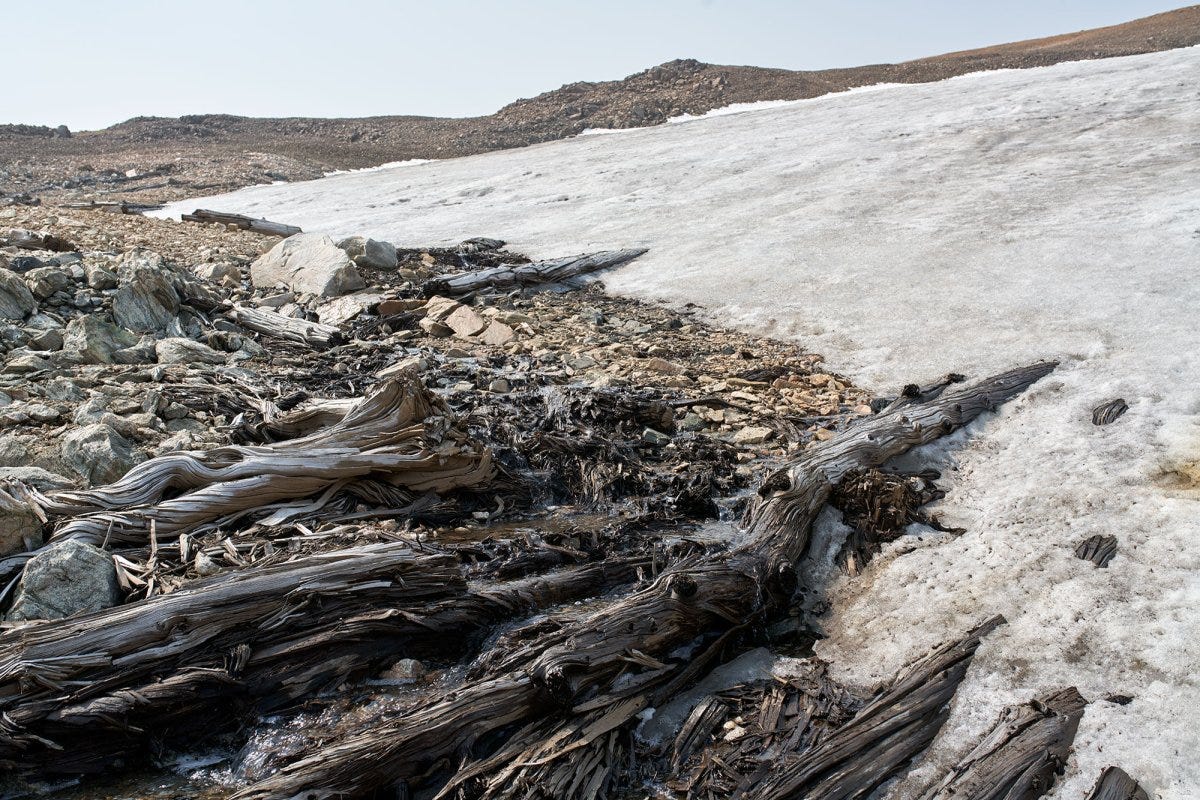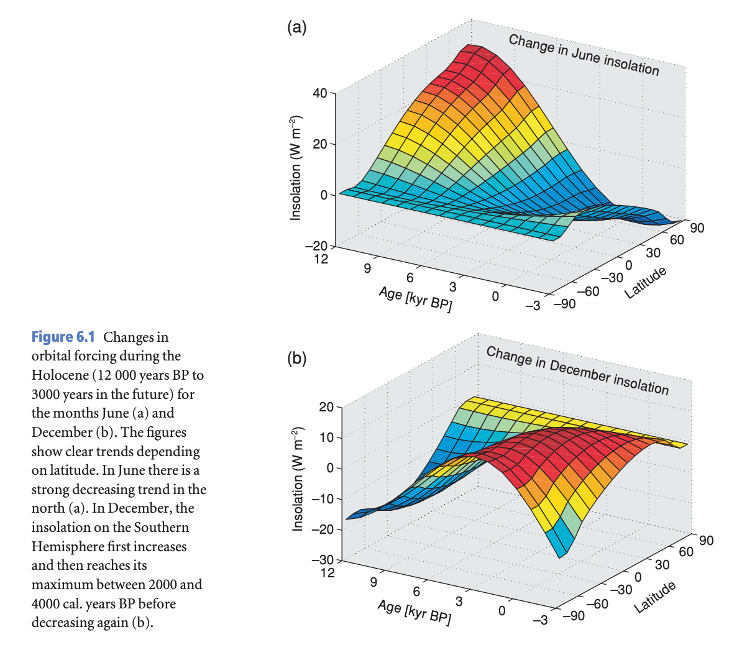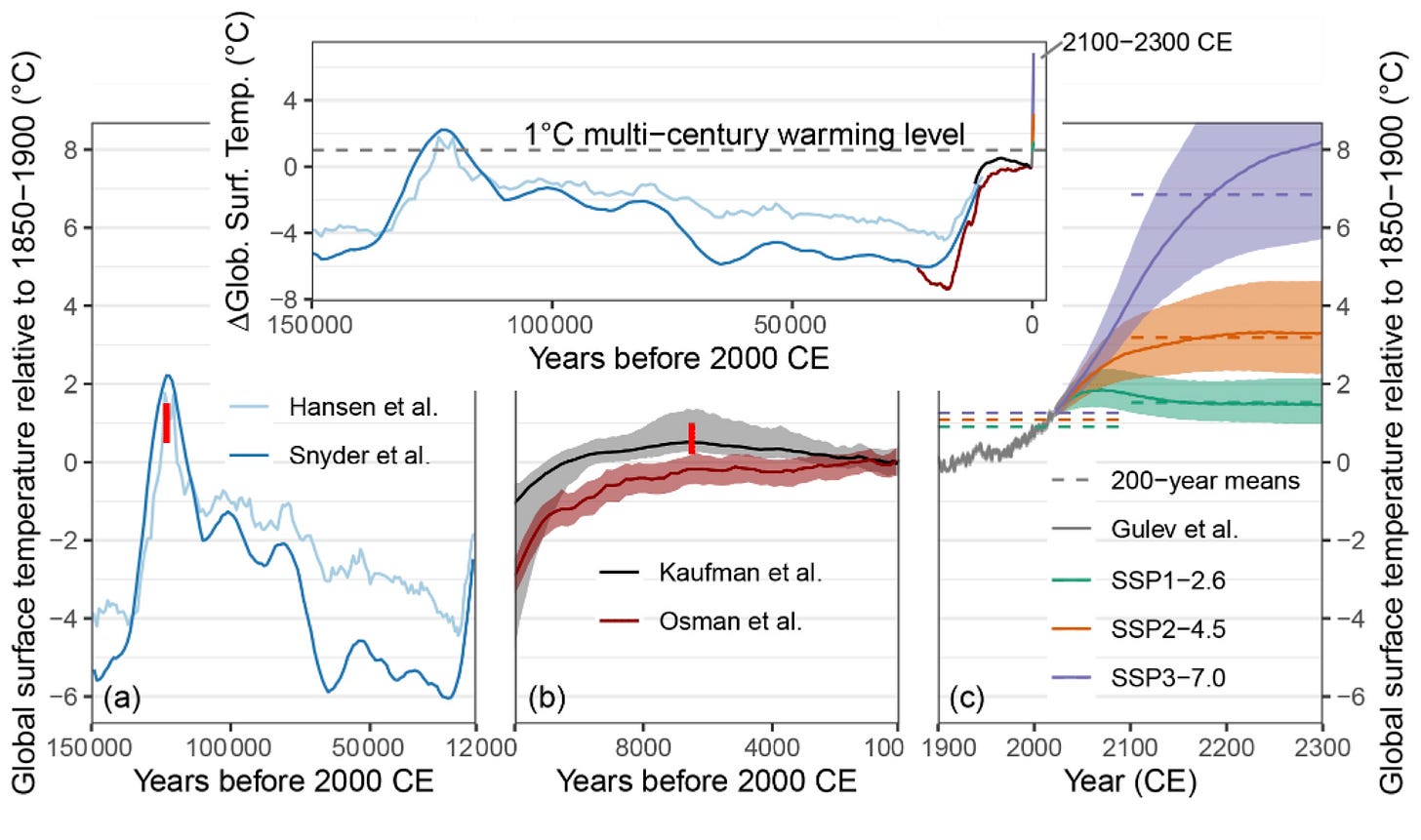Stumped! Climate skeptics are misinterpreting research about mid-Holocene forests uncovered by receding glaciers
(So I reached out to the scientists for clarity)

Climate skeptics have been known to misinterpret high-profile scientific papers in paleoclimatology, drawing conclusions that are in fact diametrically opposed to the papers’ findings.
One series of papers that skeptics have latched onto recently involves retreating glaciers that are revealing ancient forests which grew thousands of years ago. You may have seen social media posts about these studies: Skeptics point to images of tree stumps at the edge of melting ice, and suggest this is evidence that the Mid-Holocene – which occurred from roughly 8,000 years ago to about 5,000 years ago, when these forests were thriving – was warmer than present day.
On the face of it, the claim seems to make sense: If these forests grew thousands of years ago, but are today covered by glacier remnants, doesn’t this suggest Earth was warmer back then? And if that’s true, then the IPCC’s claim that Earth is warmer today than it has been over the last 125,000 years can’t be accurate!
At least that’s how the skeptic logic goes. However, I reached out to several experts in this area – including researchers who study Holocene paleoclimatology, and who encounter these receding glaciers and ancient forests in their everyday work. All of them confidently supported the IPCC’s claim about our present era being warmer globally than at any point over the last 125,000 years. And they have a very different explanation of what is going on with these tree stumps and receding glaciers:
The first thing they noted is how changing summer insolation values over the Holocene impacted treeline dynamics. I reached out to Dr. Gregory T. Pederson, a lead author of the study which gained media attention for its revelation of a whitebark pine forest in the Greater Yellowstone area – a forest which dated back to the mid-Holocene. I asked Pederson point blank whether his study cast any doubt on the IPCC’s assertions about Earth currently being warmer than at any point during the Holocene. He was unequivocal: “This study has absolutely no bearing on the fact that today, Global Mean Surface Temperatures are higher than they've been throughout the span of Holocene. That fact is absolutely true.” He went on to emphasize that the study itself tells us little about annual Global Mean Surface Temperatures during the mid-Holocene. Rather, it is more a study about mid-Holocene warm season conditions, specifically at the 45th parallel North (which runs right through Yellowstone National Park).
Pederson explained how treeline dynamics (especially alpine tree elevation) and montane glaciers are highly sensitive to seasonal insolation levels. The figure below (from work by Jürg Beer and Bas van Geel) is thus illustrative. It shows how for several thousand years before the mid-Holocene, summer insolation values were considerably elevated at northern latitudes. At the same time, these values were steadily declining over the millennia of the early Holocene – a period during which global temperatures were still rising following the end of the Last Glacial Maximum (note how during the early Holocene, December insolation levels were much lower than present across the world).

Pederson’s study shows how high alpine forests documented in Greater Yellowstone grew around 6000 years ago, when the combination of ideal climatic (temperature and precipitation) conditions, alongside ideal summertime insolation levels, persisted at that latitude. This was determined by radiocarbon dating subfossil wood preserved beneath a long-standing ice patch, using a 'floating' tree-ring chronology which was later anchored to calendar years. Then, starting around 5000 years ago, as summertime insolation at northern latitudes declined and climate conditions shifted, snow and ice accumulated, killing the forest and preserving the wood beneath the expanding glacier, until modern warming – driven by industrial-era fossil fuel combustion and deforestation – began melting the ice and revealing the ancient forest remains.
When we fast-forward to the last 150 years, we can see just how dramatic an impact anthropogenic global warming has had on global temperatures, and glacier melt: Despite lower insolation values today, greenhouse gas forcing has substantially overwhelmed the signal. Thus, we are now seeing rapid global warming when Earth’s natural forcing from changing insolation levels (which in turn relate to orbital cycles), should be leading to a cooling of Earth. The mass balance of glaciers worldwide has been declining substantially for decades (since at least the 1950s), with the melt rate accelerating in recent years.
Time lags and regional differentiation
This relates to a second point noted by experts. While the melt rate may be accelerating, it is still a relatively slow-moving phenomena compared to contemporary anthropogenic climate change. As Dr. Joe Koch, an expert in montane glacier retreat, explained to me; there is a time lag of many decades or longer in the response of glaciers to global warming. He surmised that the average temperature conditions experienced during the mid-Holocene in some of these mountainous areas is probably closer to what these regions experienced decades ago – the glaciers are melting, trying to ‘catch up’, and the tree line is expanding (upslope and northward), but the glacial extent is simply not in equilibrium with the current level of warming.
A third matter that the experts pointed out to me involved regional differences in mid-Holocene warming: As we can see in the figure above, the higher summertime insolation levels seen during the early- to mid-Holocene were not evenly distributed across the world. Due to axial tilt, the Northern Hemisphere received the most summertime sun. Sure enough, temperature proxies do point to the Northern Hemisphere being warmer than the Southern Hemisphere during the mid-Holocene. The follow-up question I wanted the experts to answer was whether the Northern Hemisphere itself was warmer in the mid-Holocene than the present-day Northern Hemisphere. This is important, because if it was warmer, it suggests that the people who lived in the higher latitudes back then had potentially endured warmer summers than we do today (and that they did so before modernity and air conditioning).
Here, the experts I spoke to seemed to express cautious doubt that mid-Holocene summers were indeed as warm as present-day summers in the Northern Hemisphere. For instance, I spoke to Dr. Alexander Thompson, whose research has played an important role in our understanding of the so-called “Holocene temperature conundrum” – an apparent mismatch between proxy records, which show a long-term cooling trend after a mid-Holocene warm peak, and climate models, which simulate continued warming over the same period (his research shows how vegetation changes over this time potentially resolves this discrepancy). Thompson noted that the warmest global temperature reconstructions from the mid-Holocene place it at roughly half a degree Celsius warmer than the pre-Industrial baseline, give or take; Yet today – a quarter of the way through the 21st Century – Earth has experienced closer to +1.4°C of warming above that same baseline: “We’ve shown in these temperature studies that even the high estimates of Northern Hemisphere summers were unlikely to be warmer than present day,” he said. That is, even if we assume that some places in the Northern Hemisphere were indeed as warm during the summertime as present day, that would mean any future warming experienced this Century unequivocally settles the question of whether there are places on Earth experiencing average temperatures not seen for over a hundred thousand years – long before humans developed any kind of complex societies or sedentary civilizations.

Just the beginning
This gets to one last point the experts I spoke to sought to emphasize: We are just beginning to see the types of Earth system responses to greenhouse gas forcings that are ‘baked in’ to the cryosphere and hydrosphere. I spoke to another well-published paleoclimatologist, Dr. Anne de Vernal, who appeared affronted by the idea such studies disproved historic present-day warmth. During our Zoom call, she interjected in my summary of what skeptics had been saying about retreating glaciers and tree stumps with an emphatic “No!” She went on to explain how while the mid-Holocene is indeed considered a warm interval, with temperatures that were slightly warmer than the pre-Industrial baseline (1850-1900), we are on track for much warmer conditions than that: “We are still in a transition phase, and there are so many retroactive feedbacks that are starting to play into the system… The response time of a glacier is long; the response time of the ocean is long, and while there may be a trend, we do not know when it could stabilize, especially since we are continuing to increase atmospheric CO2.” Another paleoclimatological expert; another emphatic expression of support for the IPCC’s claim of unmatched global warming for 125,000 years.
This is not to say there are no uncertainties about mid-Holocene warmth. The IPCC’s most recent Assessment asserts with ‘medium confidence’ that Holocene GMST ‘peaked’ at somewhere between 0.2°C and 1°C above an 1800s baseline. The main debate thus revolves around the ‘Holocene Temperature Conundrum’; or to be more direct, how ‘flat’, ‘tapered’, or ‘bulged’ the Holocene global mean surface temperature curve is relative to the pre-Industrial era. As the figure above shows, some assessments point to a gradual and continuing increase in global mean surface temperatures during the middle millennia of the Holocene, and others point to more of a ‘bulge’, with temperatures peaking roughly 6500 years ago, at about 0.7°C above the 19th Century, before declining thereafter. In either case, the vast array of temperature reconstructions point to mid-Holocene temperatures which are below the current global climate mean surface temperature anomaly of 1.4°C, and very far below the most likely 2.7°C temperature outcome scenario warming for 2100, based on current GHG emissions trajectories.
So, to sum up: No, imagery of ancient tree stumps at the edge of a receding glacier does not refute the fact that global mean surface temperatures were lower throughout the Holocene than present. While it is possible some specific locations in the Northern Hemisphere were roughly as warm back then as present day, this is little consolation, given that the world is on track for nearly double the amount of global warming seen to date, and given that the Northern Hemisphere is expected to warm more than the global average. Paleoclimatologists – especially those working on glaciers – should take note that their findings published in peer-reviewed scientific articles can be misinterpreted by skeptics to present false narratives about the exceptional rate and extent of contemporary warming.
Bio and Acknowledgements: Ryan Katz-Rosene is an Associate Professor at the University of Ottawa, where he is the incoming Associate Director of the Institute of Environment (with appointments to the School of Political Studies and Department of Geography, Environment and Geomatics). He thanks Brandon Daly for feedback provided during the preparation of this article.



